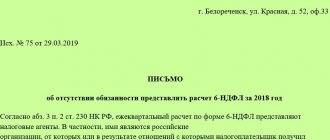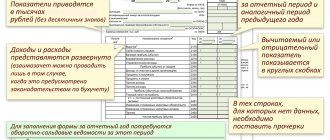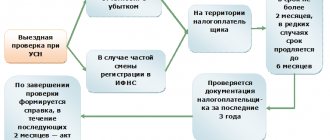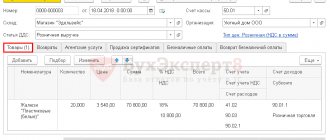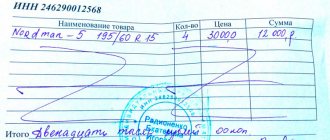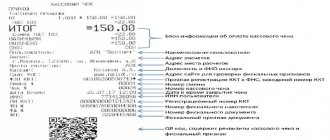Distribution of net profit of individual entrepreneurs
The profits and losses of a limited partnership are distributed among its participants in proportion to their shares in the share capital, unless otherwise provided by the constituent agreement or other agreement of the participants. An agreement to exclude any of the partnership participants from participating in profits or losses is not permitted.
The income of an entrepreneur is considered to be all funds received both in cash and in kind from the sale of goods, works, services, both self-produced and purchased, the sale of property (including securities) and property rights (income from sales).
Various aspects of production, sales, supply and financial activities receive a complete monetary assessment in the system of financial performance indicators.
The distribution of profits and losses is carried out in the accounting documentation under account 99. The uncovered loss, like profit, is shown at the end of each reporting period. The financial result is transferred to account 84, which shows the actual loss or profit of the LLC. Opening an individual entrepreneur, compared to other forms of enterprise ownership, is significantly simplified: there is no need for lengthy legal red tape or significant capital investments. But a number of actions will still have to be done.
Property taxes
Taxes under UTII are paid on real estate, for which the base is the cadastral value. Calculations and transfers are carried out for the organization as a whole. But separate accounting may be necessary to correctly record all the information.
The main thing is to correctly determine the total amount of property tax. It is necessary to take into account the mode in which the property itself is used. Internet programs such as an online calculator are a great help with this.
Under different taxation systems, an entrepreneur’s income is considered differently, and this must be taken into account. The main thing is to correctly draw up documents that record expenses and the level of current profit. It often happens that a declaration is the only suitable option for resolving the issue. Neither the tax office nor other market participants can obtain information in any other way.
IP costs that can be classified as expenses
Participants in general partnerships can only be individual entrepreneurs and (or) commercial organizations.
Consequently, no entries are made in account 80 “Authorized capital” or in account 75 “Settlements with founders” in connection with this transaction in the company’s accounting records.
The legislator regulates the distribution of profits in terms of tax revenues to budgets. Determining other areas for spending the remaining part of the profit is the prerogative of the company. The procedure for the distribution and use of profits is necessarily recorded in the constituent documents and approved by the head of the company.
It is important to remember that some activities are carried out under specific tax schemes. Therefore, all questions should be clarified before registering a business.
Accounting for income and expenses
Any entrepreneur must keep records of income and expenses. This is often necessary due to legal requirements. For example, to correctly calculate the tax base or to ensure that the maximum turnover of individual entrepreneurs is observed, to maintain the possibility of using a simplified taxation system.
But these indicators are also important for the entrepreneur himself, as they provide a clear picture of business performance. An analysis of the financial condition of an individual entrepreneur may also be useful here. Experts advise carrying out such analysis at regular intervals. This makes it possible to timely identify an unfavorable situation, as well as carry out certain measures to resolve the current situation, and it is the analysis that often makes it possible to identify specific areas that require prompt intervention.
Back to contents
How is the profit of an individual entrepreneur distributed between him and three individuals?
The Accounting Book (Section I of the Accounting Book) reflects all income received by individual entrepreneurs from carrying out entrepreneurial activities, without reducing them by tax deductions provided for by the tax legislation of the Russian Federation.
The charter of Dom LLC states that profits are distributed equally between the participants. According to the decision of the meeting dated March 28, 2018, the net profit for 2021 is in the amount of 900,000 rubles. subject to distribution among participants. Not the last place in the formation of profit is played by the innovative activity of the enterprise. It ensures the renewal of manufactured competitive products, growth in sales volumes and, accordingly, profits.
Most often, this form of cooperation between an individual entrepreneur and an individual occurs between close relatives. Unfamiliar people are unlikely to decide to engage in this form of business.
Income or profit
Income is the amount by which the company's capital increases . In this case, the contributions of the founders are not taken into account. Increasing net income is the main goal of an entrepreneur. The net profit of an individual entrepreneur is determined by subtracting all possible costs from the total (gross) profit.
These include:
- possible fines;
- taxes on personal income persons;
- interest on loans.
What taxes an entrepreneur must pay directly depends on the taxation system he chooses.
The Russian Federation provides a wide range of possible options:
- OSNO – general type of taxation.
- USN is a simplified scheme.
- UTII is a single tax on imputed income.
- Unified agricultural tax - for agricultural activities.
- Patent.
Does the individual entrepreneur pay income tax? No. Obligatory payers are legal entities. In turn, entrepreneurs make personal income tax contributions. At the same time, a profit declaration for individual entrepreneurs is not filed only with the patent option of paying taxes, since the entrepreneur provides all the indicators required to determine its size when submitting an application. In other cases, the income statement of an individual entrepreneur depends on the chosen taxation method.
On video: Profit in retail trade (Assortment management)
Distribution and use of enterprise profits
Selecting in the OKVED directory the code of the activity you plan to engage in. It will need to be indicated in the application.
To the extent that it exceeds the proportional share of participation in the authorized capital, dividends are recognized as another source of income.
The result of the company's activities for a certain period is the profit received. We will tell you in this publication how the formation, distribution and use of profit occurs, diversifying the general information with specific examples.
To the extent that it exceeds the proportional share of participation in the authorized capital, dividends are recognized as another source of income.
Profit is generated from various sources, the main of which is sales volume, defined as the difference between sales income and the accompanying costs. The amount of profit depends on:
- sales volume;
- product price levels;
- correspondence of the level of costs to the costs incurred.
The cost of acquired material resources is included in the expenses of the tax period in which income from the sale of goods, performance of work, and provision of services was actually received.
Profit as the main incentive for entrepreneurial activity meets the needs of the enterprise itself and the state as a whole. Therefore, it is important to determine not only the composition of the entrepreneur’s profit, but also to reveal the mechanism of its formation.
The cost of goods sold, work performed and services rendered is reflected taking into account the actual costs of their acquisition, implementation, provision and sale.
Profit or loss cannot be determined until the company pays all tax obligations and records full payment of the authorized capital. A decision on the distribution of profits cannot be made if, as a result, the organization has bankrupt status or the distribution of profits will lead it to this.
In your situation, you should conclude a multilateral Agreement on cooperation (joint activities).
Still have questions? Ask them to our lawyer for FREE!
Phys. persons registered in accordance with the procedure established by law and carrying out entrepreneurial activities without forming a legal entity. Another important issue is the distribution of individual entrepreneurs’ profits. It is important to know exactly what part of the profit needs to be allocated to business development, what is desirable, and what can be withdrawn from circulation and spent on your own needs. Underfunding, as well as ineffective investments, is a frequent problem, so you should approach the distribution of profits very carefully.
To prevent this from happening, loan agreements are usually drawn up. Those participants who contributed to the development of the company apply for a loan for the contributed share in relation to the individual entrepreneur himself. The profit received by the company is distributed among all participants in proportion to their contributions.
Skills and knowledge (do you know the algorithms for preparing accounting entries or are you well versed in vehicle repairs?
Which tax system should you choose?
Depending on what condition of income distribution is specified in the agreement between the allies, profits can be divided equally or within specified limits.
Withdraws cash from the current account through the cash desk at the bank. In this case, you must indicate in the purpose of the payment that the money is withdrawn for personal needs.
Thus, income in the form of dividends received by an individual entrepreneur as a participant in an LLC will be subject to personal income tax at a tax rate of 9% (clause 4 of Article 224 of the Tax Code of the Russian Federation) if he is a tax resident of Russia, or at a rate of 15% if he is not recognized as a tax resident of the Russian Federation (clause 3 of Article 224 of the Tax Code of the Russian Federation).
To avoid problems, it is better not to withdraw large sums and try to pay expenses by card, as well as provide the bank with clarifications and documents in a timely manner, if necessary.
It is difficult to take into account expenses if expenses are from one card
Entrepreneurs can spend money for personal purposes directly from their current account or use a corporate card as their own.
If an individual entrepreneur has “income” on UTII, a patent or the simplified tax system, this does not create any problems for the accountant. But under the simplified tax system “income-expenses” or OSNO, personal expenses will have to be excluded from tax-reducing expenses. Only targeted expenses supported by documents should remain: checks, receipts, etc.
This is not difficult if there are few such expenses. What if an entrepreneur really uses a business card as a personal one and uses it to pay for purchases at the grocery store, gas station and coffee? This will make your work much more difficult.
Enterprise profit distribution
The issue of paying dividends from previous years also remained controversial for a long time. Until 2002, the Ministry of Finance was of the opinion that the company did not have a legal obligation to distribute the profits of previous years, therefore the transaction on the distribution of income was void.
The concept of dividends is applicable to legal entities and, accordingly, taxation provided for by the provisions of the Tax Code is also applicable to legal entities.
The law does not require an individual entrepreneur to have any fixed amount to start a business; entrepreneurship does not officially require initial funds. But business always involves some costs, and you will definitely have to invest. The capital of an individual entrepreneur, however, remains at his discretion.
It follows that an individual entrepreneur is not a legal entity and does not form an authorized capital to carry out entrepreneurial activities.
Your income is taxed once depending on the regime: personal income tax, simplified tax system, PSN, UTII or Unified Agricultural Tax. You do not need to pay any additional taxes on the funds you withdraw from your account. There is no need to deposit funds withdrawn for personal needs into KUDiR, because this is not an expense.
The partnership is liable for its obligations with all its property. If the company's property is insufficient, the creditor has the right to make a claim against any general partner or all of them at once to fulfill the obligation.
Shareholders bear the risk of losses associated with the company's activities within the limits of the value of the shares they own.
Each set of documents is prepared strictly in accordance with the current legislation of the Russian Federation and, before being submitted to the Federal Tax Service for registration, undergoes a very high-quality check by a lawyer.
Expenses on material resources purchased for future use, or used for the manufacture of goods (performance of work, provision of services), not sold in the tax period, and also not fully used in the reporting tax period, are taken into account when receiving income from sales in subsequent tax periods.
The goal of any business activity is to make a profit. The totality of profit and interest received from its use forms the finances of the individual entrepreneur.
